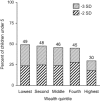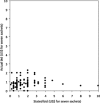Willingness to pay for lipid-based nutrient supplements for young children in four urban sites of Ethiopia
- PMID: 23241477
- PMCID: PMC6860283
- DOI: 10.1111/mcn.12022
Willingness to pay for lipid-based nutrient supplements for young children in four urban sites of Ethiopia
Abstract
Malnutrition in children under 5 years of age is pervasive in Ethiopia across all wealth quintiles. The objective of this study was to determine the willingness to pay (WTP) for a week's supply of Nutributter® (a lipid-based nutrient supplement, or LNS) through typical urban Ethiopian retail channels. In February, 2012, 128 respondents from 108 households with 6-24-month-old children had the opportunity to sample Nutributter® for 2 days in their homes as a complementary food. Respondents were asked directly and indirectly what they were willing to pay for the product, and then participated in market simulation where they could demonstrate their WTP through an exchange of real money for real product. Nearly all (96%) of the respondents had a positive WTP, and 25% were willing to pay the equivalent of at least $1.05, which we calculated as the likely minimum, unsubsidised Ethiopian retail price of Nutributter® for 1 week for one child. Respondents willing to pay at least $1.05 included urban men and women with children 6-24 months old from low-, middle- and high-wealth groups from four study sites across three cities. Additionally, we estimated the initial annual market size for Nutributter® in the cities where the study took place to be around $500 000. The study has important implications for retail distribution of LNS in Ethiopia, showing who the most likely customers could be, and also suggesting why the initial market may be too small to be of interest to food manufacturers seeking profit maximisation.
Keywords: Ethiopia; Lipid-based Nutrient Supplement (LNS); Nutributter®; malnutrition; retail distribution; willingness to pay.
© 2012 Blackwell Publishing Ltd.
Conflict of interest statement
The authors declare that they have no conflicts of interest.
Figures








References
-
- Adams K.P., Vosti S.A., Lybbert T.J. & Ayifah E. (2011) Integrating Economic Analysis with a Randomized Controlled Trial: Willingness‐to‐Pay for a New Maternal Nutrient Supplement. In: Agricultural and Applied Economics Association, 2011 Annual Meeting, Pittsburgh, Pennsylvania, July 24–26, 2011. Available at: http://EconPapers.repec.org/RePEc:ags:aaea11:103793 (Accessed 11 June 2012).
-
- Adu‐Afarwuah S., Lartey A., Brown K.H., Zlotkin S., Briend A. & Dewey K. (2008) Home fortification of complementary foods with micronutrient supplements is well accepted and has positive effects on infant iron status in Ghana. The American Journal of Clinical Nutrition 87, 929–938. - PubMed
-
- Banerjee A. & Duflo E. (2011) Poor Economics: A Radical Rethinking of the Way to Fight Global Poverty. Public Affairs: New York.
-
- Becker G., DeGroot M. & Marschak J. (1964) Measuring utility by a single‐response sequential method. Behavioral Science 9, 226–236. - PubMed
-
- Belete P. (2012) Fafa first to produce powdered milk in Ethiopia. Capital Ethiopia, 28 March. Available at: http://capitalethiopia.com/index.php?option=com_content%26view=article%2... (Accessed 1 June 2012).
Publication types
MeSH terms
LinkOut - more resources
Full Text Sources
Other Literature Sources
Medical

